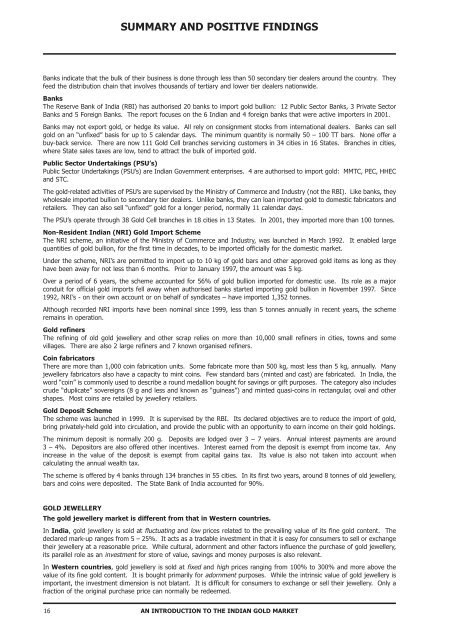Indian Gold Book:Indian Gold Book - Gold Bars Worldwide
Indian Gold Book:Indian Gold Book - Gold Bars Worldwide
Indian Gold Book:Indian Gold Book - Gold Bars Worldwide
Create successful ePaper yourself
Turn your PDF publications into a flip-book with our unique Google optimized e-Paper software.
SUMMARY AND POSITIVE FINDINGS<br />
Banks indicate that the bulk of their business is done through less than 50 secondary tier dealers around the country. They<br />
feed the distribution chain that involves thousands of tertiary and lower tier dealers nationwide.<br />
Banks<br />
The Reserve Bank of India (RBI) has authorised 20 banks to import gold bullion: 12 Public Sector Banks, 3 Private Sector<br />
Banks and 5 Foreign Banks. The report focuses on the 6 <strong>Indian</strong> and 4 foreign banks that were active importers in 2001.<br />
Banks may not export gold, or hedge its value. All rely on consignment stocks from international dealers. Banks can sell<br />
gold on an “unfixed” basis for up to 5 calendar days. The minimum quantity is normally 50 – 100 TT bars. None offer a<br />
buy-back service. There are now 111 <strong>Gold</strong> Cell branches servicing customers in 34 cities in 16 States. Branches in cities,<br />
where State sales taxes are low, tend to attract the bulk of imported gold.<br />
Public Sector Undertakings (PSU’s)<br />
Public Sector Undertakings (PSU’s) are <strong>Indian</strong> Government enterprises. 4 are authorised to import gold: MMTC, PEC, HHEC<br />
and STC.<br />
The gold-related activities of PSU’s are supervised by the Ministry of Commerce and Industry (not the RBI). Like banks, they<br />
wholesale imported bullion to secondary tier dealers. Unlike banks, they can loan imported gold to domestic fabricators and<br />
retailers. They can also sell “unfixed” gold for a longer period, normally 11 calendar days.<br />
The PSU’s operate through 38 <strong>Gold</strong> Cell branches in 18 cities in 13 States. In 2001, they imported more than 100 tonnes.<br />
Non-Resident <strong>Indian</strong> (NRI) <strong>Gold</strong> Import Scheme<br />
The NRI scheme, an initiative of the Ministry of Commerce and Industry, was launched in March 1992. It enabled large<br />
quantities of gold bullion, for the first time in decades, to be imported officially for the domestic market.<br />
Under the scheme, NRI’s are permitted to import up to 10 kg of gold bars and other approved gold items as long as they<br />
have been away for not less than 6 months. Prior to January 1997, the amount was 5 kg.<br />
Over a period of 6 years, the scheme accounted for 56% of gold bullion imported for domestic use. Its role as a major<br />
conduit for official gold imports fell away when authorised banks started importing gold bullion in November 1997. Since<br />
1992, NRI’s - on their own account or on behalf of syndicates – have imported 1,352 tonnes.<br />
Although recorded NRI imports have been nominal since 1999, less than 5 tonnes annually in recent years, the scheme<br />
remains in operation.<br />
<strong>Gold</strong> refiners<br />
The refining of old gold jewellery and other scrap relies on more than 10,000 small refiners in cities, towns and some<br />
villages. There are also 2 large refiners and 7 known organised refiners.<br />
Coin fabricators<br />
There are more than 1,000 coin fabrication units. Some fabricate more than 500 kg, most less than 5 kg, annually. Many<br />
jewellery fabricators also have a capacity to mint coins. Few standard bars (minted and cast) are fabricated. In India, the<br />
word “coin” is commonly used to describe a round medallion bought for savings or gift purposes. The category also includes<br />
crude “duplicate” sovereigns (8 g and less and known as “guineas”) and minted quasi-coins in rectangular, oval and other<br />
shapes. Most coins are retailed by jewellery retailers.<br />
<strong>Gold</strong> Deposit Scheme<br />
The scheme was launched in 1999. It is supervised by the RBI. Its declared objectives are to reduce the import of gold,<br />
bring privately-held gold into circulation, and provide the public with an opportunity to earn income on their gold holdings.<br />
The minimum deposit is normally 200 g. Deposits are lodged over 3 – 7 years. Annual interest payments are around<br />
3 – 4%. Depositors are also offered other incentives. Interest earned from the deposit is exempt from income tax. Any<br />
increase in the value of the deposit is exempt from capital gains tax. Its value is also not taken into account when<br />
calculating the annual wealth tax.<br />
The scheme is offered by 4 banks through 134 branches in 55 cities. In its first two years, around 8 tonnes of old jewellery,<br />
bars and coins were deposited. The State Bank of India accounted for 90%.<br />
GOLD JEWELLERY<br />
The gold jewellery market is different from that in Western countries.<br />
In India, gold jewellery is sold at fluctuating and low prices related to the prevailing value of its fine gold content. The<br />
declared mark-up ranges from 5 – 25%. It acts as a tradable investment in that it is easy for consumers to sell or exchange<br />
their jewellery at a reasonable price. While cultural, adornment and other factors influence the purchase of gold jewellery,<br />
its parallel role as an investment for store of value, savings and money purposes is also relevant.<br />
In Western countries, gold jewellery is sold at fixed and high prices ranging from 100% to 300% and more above the<br />
value of its fine gold content. It is bought primarily for adornment purposes. While the intrinsic value of gold jewellery is<br />
important, the investment dimension is not blatant. It is difficult for consumers to exchange or sell their jewellery. Only a<br />
fraction of the original purchase price can normally be redeemed.<br />
16<br />
AN INTRODUCTION TO THE INDIAN GOLD MARKET

















